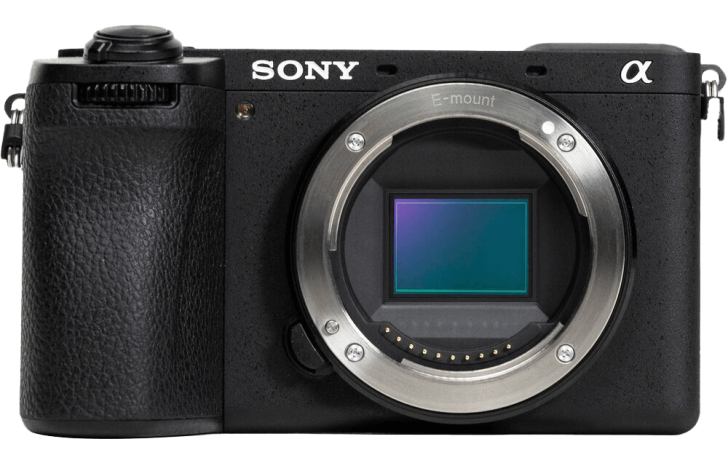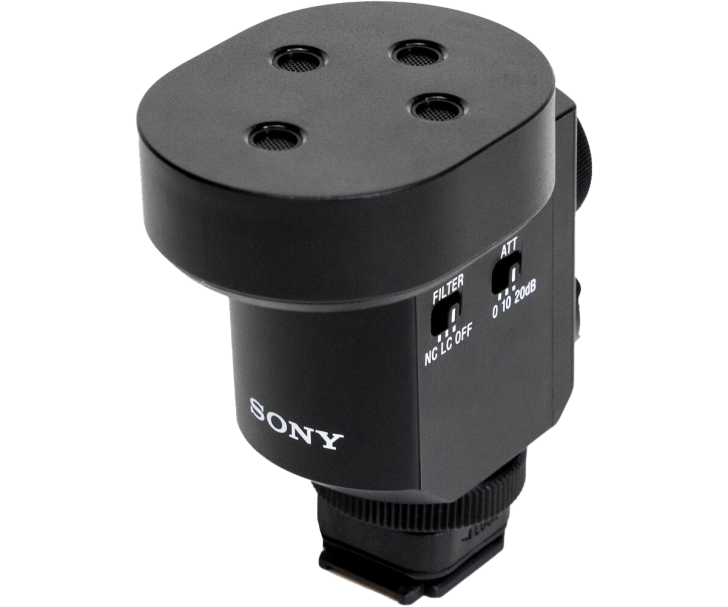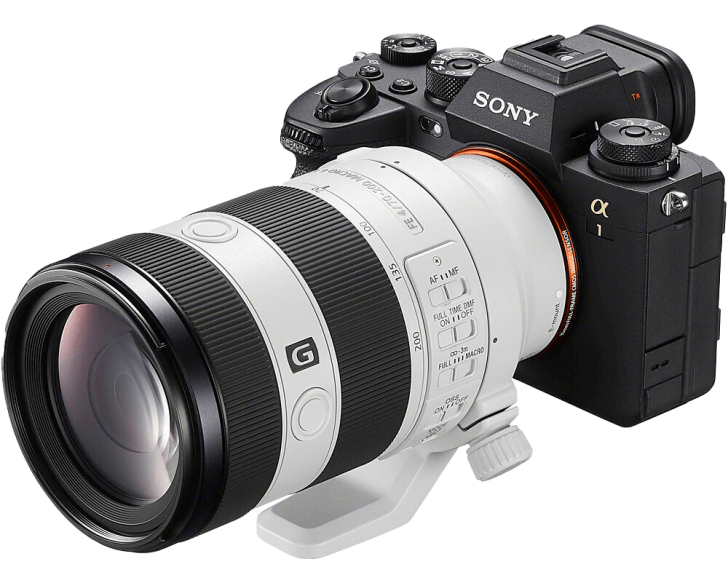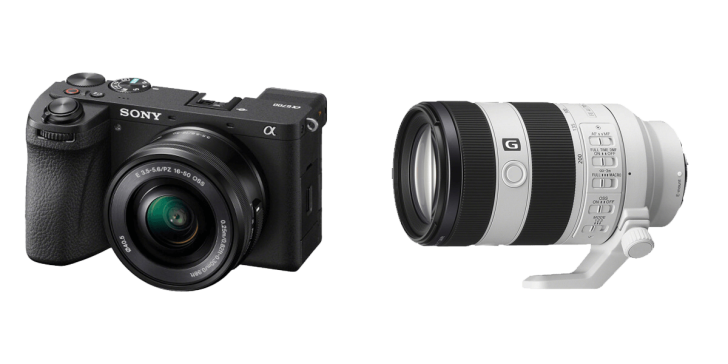Sony has announced a trio of major upgrades to its photo and video lineup: the a6700 mirrorless camera, FE 70-200mm f/4 G OSS II lens, and ECM-M1 on-camera microphone. Combining video features from Sony’s cinema-line with AI-driven tech, the a6700 elevates Sony’s APS-C lineup for creators while retaining its signature compact form. Complementing the new camera is the ECM-M1 on-camera microphone, which uses beamforming technology to offer an unprecedented eight recording modes. Finally, the re-imagined FE 70-200mm f/4 G OSS II is smaller, lighter, and sharper than its predecessor.
Preorders for the new Sony gear start July 13, 2023 at 10AM ET

a6700 Mirrorless Camera
The a6700 combines the 26.0 MP APS-C BSI Exmor R CMOS sensor found in the FX30 with the BIONZ XR processor of the ZV-E1. Compared to the a6600, the a6700 features a new sensor design with more megapixels supported by 8x more processing power. With an ISO range of 100-32,000, expandable to 50-102,400 for stills, you can enter nearly any lighting environment with confidence. Colors appear natural and noise is minimal. An updated AE algorithm also improves skin tone rendering and is 20% more reliable overall, compared to the a6600.
Autofocus receives an upgrade, too, thanks to a dedicated AI-processing unit that offers a handful of conveniences, from advanced subject recognition to real-time tracking and auto-framing. The AF system uses 759 phase-detection points, which cover 93% of the image area—nearly double the a6600’s 425 points.
The a6700 can shoot up to 11 fps with AF/AE tracking using either mechanical or electronic shutter modes. Meanwhile, bursts of more than 1,000 JPEGs or 59 compressed RAW files are possible, keeping you on top of the action. Anti-flicker functionality adjusts your shutter to synchronize with artificial light flicker. Focus bracketing up to 299 images, as well as time-lapse creation, can be done in-camera.
5-axis in-body image stabilization provides five steps of correction for smooth and steady capture when shooting handheld or at low shutter speeds. Active mode stabilization utilizes an advanced algorithm to compensate for camera shake when recording video.
As a camera built for multimedia creators, the a6700 incorporates an impressive array of video features drawn from Sony’s cinema lineup. 6K oversampling is used, collecting 2.4x the amount of data needed for 4K videos, minimizing distortion and producing sharper image quality. Full-pixel readout 4K recording is also possible, as well as slow-motion recording at up to 5x in 4K or 10x in FHD.
S-Cinetone uses the same color science as Sony’s more advanced cameras for beautiful imagery out of the gate. S-Log3 or HLG can also be used to leverage the 14 stops of dynamic range in the editing room. LUTs can be applied while recording to preview the look of a shot.
The a6700 maintains advanced AF functionality while zooming, including breathing compensation, AF assist, and focus mapping and peaking. A Multi Interface shoe, as well as mic and headphone jacks, elevate audio recording.
A vari-angle, 1.03m-dot touchscreen panel adds flexibility to view and modify recording, while its 2.36m-dot XGA OLED EVF provides crystal clear viewing at 120 fps. The a6700 is slightly larger, but lighter than the a6600. Its ergonomics have been modified for easier handling. Dials and controls have also been modified to streamline operation. The a6700 is dust and moisture resistant, so you can take it virtually anywhere.
Streaming in 4K (15p/30p) or FHD (30p/60p) is possible with the a6700 via USB. 2.4 GHz/5 GHz Wi-Fi is also supported. Smartphone connectivity provides another wireless means of transferring files.

ECM-M1 On-Camera Microphone
A perfect companion for the a6700, the ECM-M1 on-camera microphone is the most evolved on-camera shotgun mic from Sony to date. Whether recording yourself, an interview between multiple people, or a targeted part of an environment, there is a setting to achieve the needed footage.
The ECM-M1 owes its functionality to four microphone capsules and innovative beamforming technology. It offers three types of directivity and eight audio recording modes for capturing audio with precision from nearly any part of your surroundings. An intuitive directivity mode dial makes choosing the right setting quick and easy. It also offers 4-channel recording for backup “safety” recordings.
Internal digital signal processing suppresses noise for clear recording. A noise-cut filter removes unpleasant noises through digital signal processing, while a low-cut filter tackles wind, air-conditioners, or mechanical rumble. A wind screen is also provided for outdoor recording.
The overall construction of the ECM-M1 is compact and lightweight, so it won’t take up much space or get in the way when in use. Audio is transmitted directly to your camera via the Multi Interface Shoe.

FE 70-200mm f/4 G OSS II
Finally, Sony has also announced the FE 70-200mm f/4 G OSS II, which improves upon an already popular and versatile telephoto zoom. Key among its updates is a better optical design and smaller build.
Compared to its first iteration, the new zoom is 15% shorter and slightly lighter for easier carry and handheld use. The new 70-200mm allows you to get even closer to subjects, offering half life-size macro capabilities across the entire zoom range. Focusing is possible as close as 3.5″ at the wide end, or 7.5″ at the long end, and when the lens is combined with the optional 2.0x teleconverter, fully life-size macro performance is available.
Four XD linear motors, two for each focus group, power quick and quiet autofocusing that is 20% faster than its predecessor. AF tracking is supported while zooming, as well as blackout-free 30 fps continuous shooting when used with the a1. Linear response manual focusing feels smooth and natural.
Optically, the lens has a new design that includes a mix of advanced elements to combat chromatic and spherical aberrations of all flavors for distortion-free images. Corner-to-corner sharpness has been improved across the zoom range. Internal floating focusing offers high-resolution capture at any distance. A 9-bladed circular aperture renders natural looking bokeh and subject-background separation.
A host of on-lens controls simplify use in the field, including: three customizable focus hold buttons, three modes of optical image stabilization, a zoom lock switch, AF/MF switch, full time DMF switch, and focus range limiter. A removable tripod mount is also included.
The 70-200mm f/4 is dust and moisture resistant for safe outdoor use and a fluorine coating has been applied to the front element to repel water, oil, and other contaminants.
Preorders for the new Sony gear start July 13, 2023 at 10AM ET


I'm a stills shooter, so to me, this looks like mainly an incremental improvement over the 4-year-old a6600. That's to be expected, as the mirrorless marketplace has matured. I'm sure the AF and subject tracking have improved as would be expected with 2-1/2 generations of Moore's Law, not to mention the tremendous advances in "AI" over the past few years. The video improvements look impressive, but I can't comment beyond the raw specs because I rarely shoot video.
The main question in my mind is whether these improvements will be compelling enough for a6600 users to upgrade en masse.
The second question is whether Sony will replace the a6100 and a6400 based on the this sensor and processor. 6200 is the only number still available in their current numbering scheme, unless they want to go to 50's.